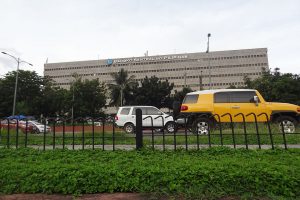Holiday spending unlikely to give ‘meaningful’ boost to full-year growth

By Luisa Maria Jacinta C. Jocson, Reporter
THE EXPECTED SURGE in household spending during the holiday season may not be enough to ensure that Philippine annual gross domestic product (GDP) growth will hit the government’s 6-7% target, analysts said.
“We don’t think the holiday spending will provide a meaningful boost to annual growth, as pandemic-related restrictions were already mostly loosened during the same period last year so this will likely not affect annual comparison much,” Makoto Tsuchiya, assistant economist at Oxford Economics, said in an e-mail.
Economic managers have kept the 6-7% full-year target range, even as GDP growth averaged 5.5% as of end-September.
The economy would need to grow by 7.2% in the fourth quarter to meet the lower end of the government’s GDP growth goal.
“I don’t see the government’s target for 2023 as being feasible, at all, despite the stronger-than-expected result for the third quarter… the holiday shouldn’t matter too much in year-on-year growth terms, which by definition strips out the impact of such seasonality,” Pantheon Chief Emerging Asia Economist Miguel Chanco said in an e-mail.
Philippine GDP expanded by 5.9% in the third quarter, ending three consecutive quarters of slowing growth.
Mr. Chanco said the third-quarter growth print was mainly driven by the spike in government spending.
“More importantly, the third-quarter headline growth bounce masked a continued slowdown in private consumption growth, which is the economy’s main engine,” he added.
Household consumption, which typically accounts for about three-fourths of the economy, grew by 5% in the third quarter. This was slower than the 8% growth a year ago and 5.5% in the previous quarter. It was also the weakest rise in household consumption in two years.
Domestic consumption is expected to surge in the fourth quarter as consumers spend more during the holidays. However, elevated inflation may put a damper on holiday spending.
“From third-quarter data, it is obvious that the private sector has been softening, and the growth was led by the public sector. However, given the accumulated debt and limited fiscal space, the government won’t be able to fully offset the weakness in the private sector,” Mr. Tsuchiya said.
Oxford Economics expects Philippine GDP growth to average 5% this year amid muted demand.
“External demand will remain subdued given the slowing global economy, while investment will be hampered by elevated interest rates and low external demand. This will translate to the labor market weakness, when households already need to tighten their purse strings given the need to rebuild savings,” he added.
Mr. Chanco also noted that the Bangko Sentral ng Pilipinas (BSP) could cut rates to support economic growth as inflation eases.
“As fiscal policy is still stretched from the COVID-era expansion of the deficit, the only real macroeconomic policy lever that’s available in the Philippines is a gradual unwinding of the BSP’s aggressive rate hikes, which should be doable in the not-too-distant future, as long as inflation continues to trend downwards in the coming months,” he added.
At last month’s policy meeting, the BSP kept borrowing costs steady at 6.5%, the highest in 16 years. From May 2022 to October, BSP raised policy rates by a total of 450 bps to curb inflation.
BMI Country Risk and Industry Research last month said it projects household spending in the Philippines to grow by 6.3% in 2024.
“Our consumer spending outlook will be more positive, relative to 2023, as economic growth persists, and consumption levels normalize. Easing inflationary pressures and healthy employment will form the base for stable consumer spending,” BMI, a unit of Fitch Solutions, said in a note in November.
However, it said that high levels of household debt remain a risk to the consumer outlook.
“It limits the future availability of debt, but also draws on current disposable income levels, especially as debt servicing costs increase on the back of interest rate increases,” BMI added.




